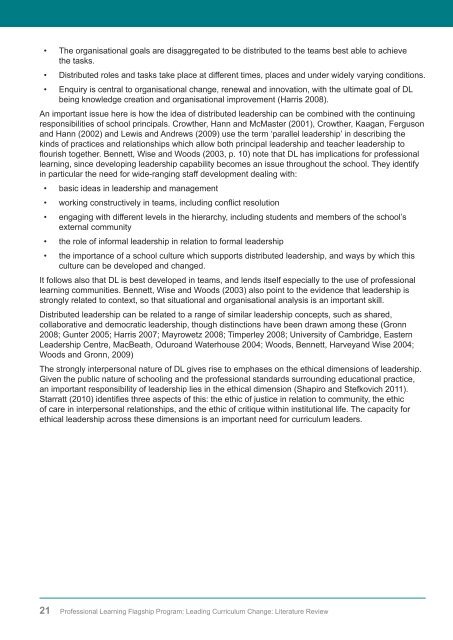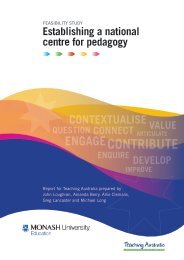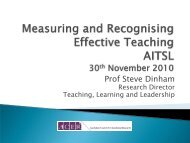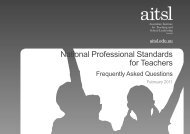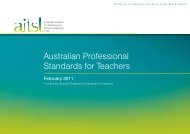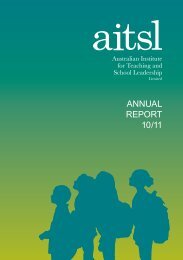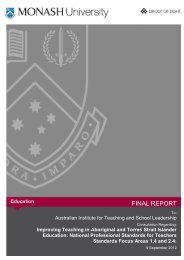Professional Learning Flagship Program: Leading Curriculum Change
Professional Learning Flagship Program: Leading Curriculum Change
Professional Learning Flagship Program: Leading Curriculum Change
You also want an ePaper? Increase the reach of your titles
YUMPU automatically turns print PDFs into web optimized ePapers that Google loves.
• The organisational goals are disaggregated to be distributed to the teams best able to achievethe tasks.• Distributed roles and tasks take place at different times, places and under widely varying conditions.• Enquiry is central to organisational change, renewal and innovation, with the ultimate goal of DLbeing knowledge creation and organisational improvement (Harris 2008).An important issue here is how the idea of distributed leadership can be combined with the continuingresponsibilities of school principals. Crowther, Hann and McMaster (2001), Crowther, Kaagan, Fergusonand Hann (2002) and Lewis and Andrews (2009) use the term ‘parallel leadership’ in describing thekinds of practices and relationships which allow both principal leadership and teacher leadership toflourish together. Bennett, Wise and Woods (2003, p. 10) note that DL has implications for professionallearning, since developing leadership capability becomes an issue throughout the school. They identifyin particular the need for wide-ranging staff development dealing with:• basic ideas in leadership and management• working constructively in teams, including conflict resolution• engaging with different levels in the hierarchy, including students and members of the school’sexternal community• the role of informal leadership in relation to formal leadership• the importance of a school culture which supports distributed leadership, and ways by which thisculture can be developed and changed.It follows also that DL is best developed in teams, and lends itself especially to the use of professionallearning communities. Bennett, Wise and Woods (2003) also point to the evidence that leadership isstrongly related to context, so that situational and organisational analysis is an important skill.Distributed leadership can be related to a range of similar leadership concepts, such as shared,collaborative and democratic leadership, though distinctions have been drawn among these (Gronn2008; Gunter 2005; Harris 2007; Mayrowetz 2008; Timperley 2008; University of Cambridge, EasternLeadership Centre, MacBeath, Oduroand Waterhouse 2004; Woods, Bennett, Harveyand Wise 2004;Woods and Gronn, 2009)The strongly interpersonal nature of DL gives rise to emphases on the ethical dimensions of leadership.Given the public nature of schooling and the professional standards surrounding educational practice,an important responsibility of leadership lies in the ethical dimension (Shapiro and Stefkovich 2011).Starratt (2010) identifies three aspects of this: the ethic of justice in relation to community, the ethicof care in interpersonal relationships, and the ethic of critique within institutional life. The capacity forethical leadership across these dimensions is an important need for curriculum leaders.21 <strong>Professional</strong> <strong>Learning</strong> <strong>Flagship</strong> <strong>Program</strong>: <strong>Leading</strong> <strong>Curriculum</strong> <strong>Change</strong>: Literature Review


